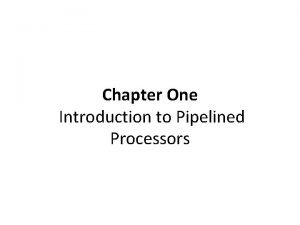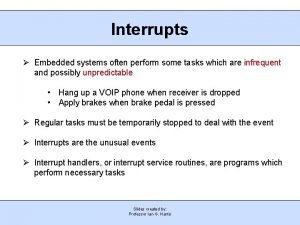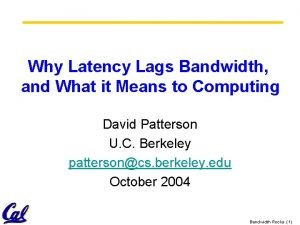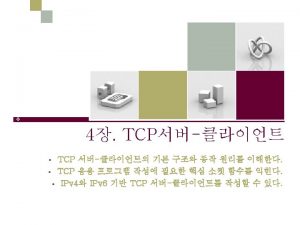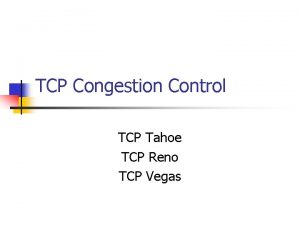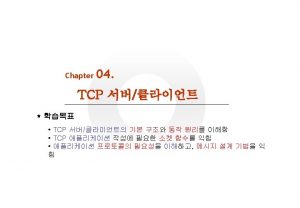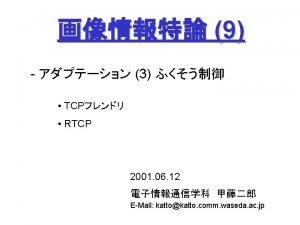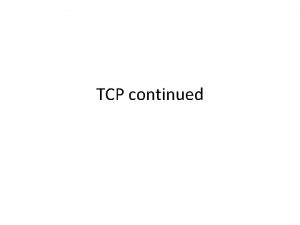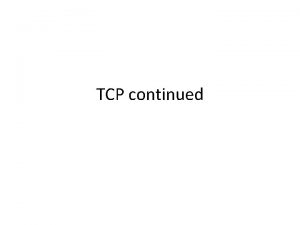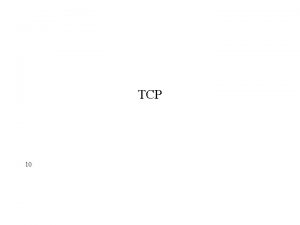TCP latency modeling 1 TCP latency modeling Q












- Slides: 12

TCP latency modeling 1

TCP latency modeling Q: How long does it take to Notation, assumptions: receive an object from a r Assume one link between Web server after sending client and server of rate R a request? r Assume: fixed congestion r TCP connection establishment window, W segments r data transfer delay r S: MSS (bits) r O: object size (bits) r no retransmissions m no loss, no corruption 2

TCP latency modeling Optimal Setting: Time = O/R Two cases to consider: r WS/R > RTT + S/R: m ACK for first segment in window returns before window’s worth of data sent r WS/R < RTT + S/R: m wait for ACK after sending window’s worth of data sent 3

TCP latency Modeling Case 1: latency = 2 RTT + O/R K: = O/WS Case 2: latency = 2 RTT + O/R + (K-1)[S/R + RTT - WS/R] 4

TCP Latency Modeling: Slow Start r Now suppose window grows according to slow start. r Will show that the latency of one object of size O is: where P is the number of times TCP stalls at server: - where Q is the number of times the server would stall if the object were of infinite size. - and K is the number of windows that cover the object. 5

TCP Latency Modeling: Slow Start (cont. ) Example: O/S = 15 segments K = 4 windows Q=2 P = min{K-1, Q} = 2 Server stalls P=2 times. 6

TCP Latency Modeling: Slow Start (cont. ) 7

Flow Control 8

TCP Flow Control flow control sender won’t overrun receiver’s buffers by transmitting too much, too fast Rcv. Buffer = size or TCP Receive Buffer Rcv. Window = amount of spare room in Buffer receiver: explicitly informs sender of (dynamically changing) amount of free buffer space m Rcv. Window field in TCP segment sender: keeps the amount of transmitted, un. ACKed data less than most recently received Rcv. Window receiver buffering 9

TCP: setting timeouts 10

TCP Round Trip Time and Timeout Q: how to set TCP timeout value? r longer than RTT note: RTT will vary r too short: premature timeout m unnecessary retransmissions r too long: slow reaction to segment loss m Q: how to estimate RTT? r Sample. RTT: measured time from segment transmission until ACK receipt m ignore retransmissions, cumulatively ACKed segments r Sample. RTT will vary, want estimated RTT “smoother” m use several recent measurements, not just current Sample. RTT 11

TCP Round Trip Time and Timeout Estimated. RTT = (1 -x)*Estimated. RTT + x*Sample. RTT r Exponential weighted moving average r influence of given sample decreases exponentially fast r typical value of x: 0. 1 Setting the timeout r Estimted. RTT plus “safety margin” r large variation in Estimated. RTT -> larger safety margin Timeout = Estimated. RTT + 4*Deviation = (1 -x)*Deviation + x*|Sample. RTT-Estimated. RTT| 12
 Modeling role modeling theory
Modeling role modeling theory Relational vs dimensional data modeling
Relational vs dimensional data modeling Low latency dispersion compensator
Low latency dispersion compensator Latency in computer architecture
Latency in computer architecture Oral stage of development examples
Oral stage of development examples Motion-to-photon latency
Motion-to-photon latency Mparticle latency
Mparticle latency Nvlink latency
Nvlink latency Greedy cycle in computer architecture
Greedy cycle in computer architecture Tccr register
Tccr register Modern newfangled 6 3
Modern newfangled 6 3 Ull cmaf
Ull cmaf Improve memory latency
Improve memory latency








